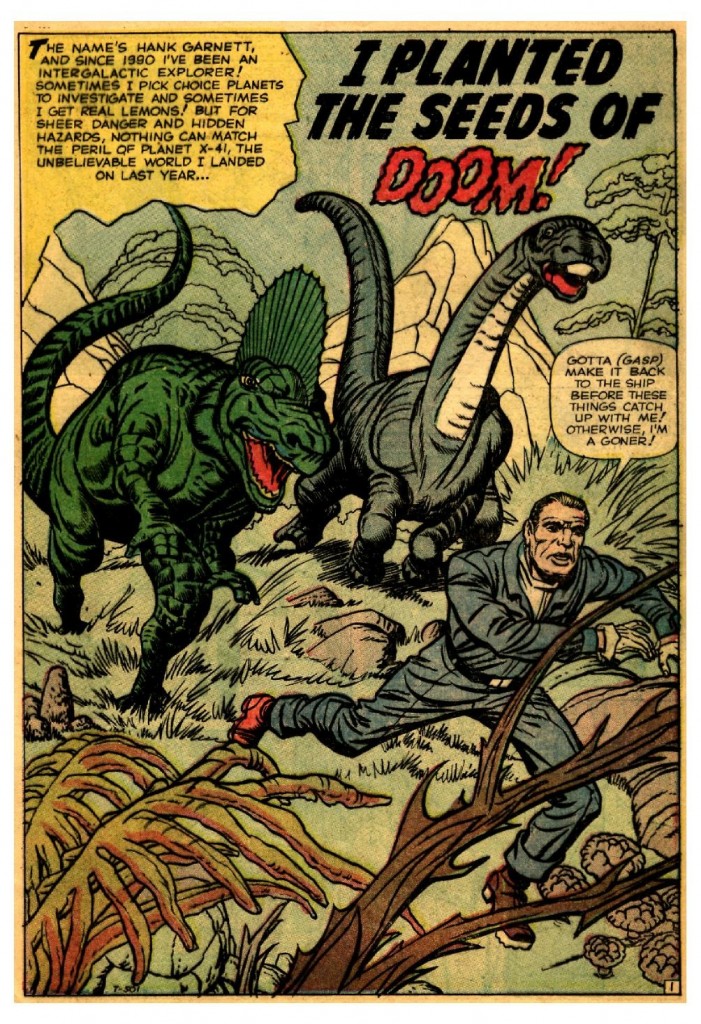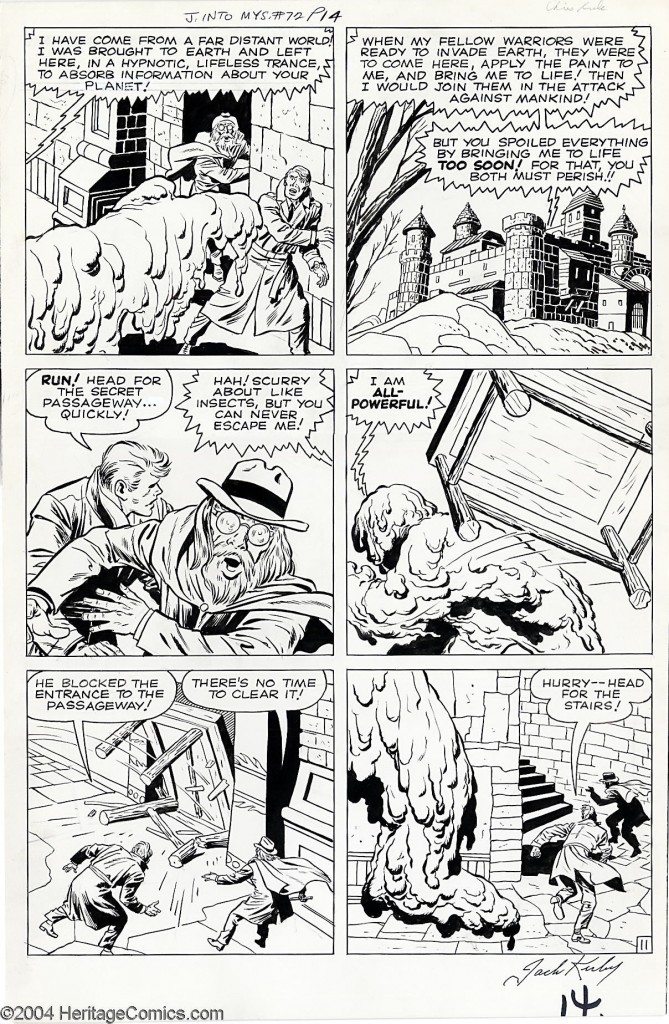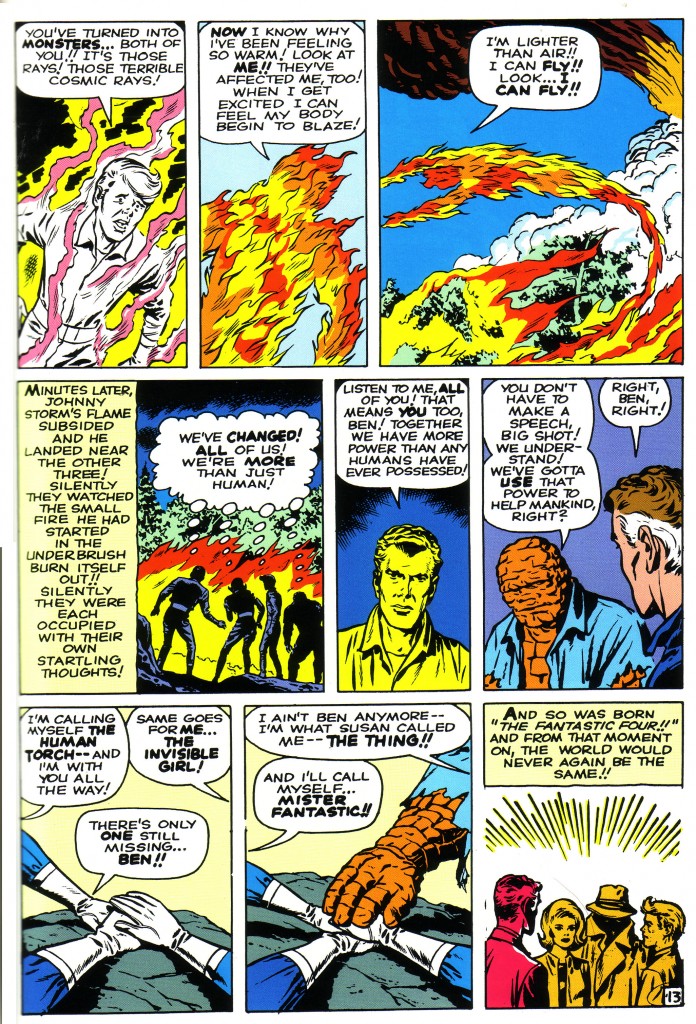In my last blog entry, I showed an incredible double spread from The Fly #1, which was actually one of the first Kirby comics I had encountered as a child. Probably at about the same time, I started reading Atlas/Marvel’s Kirby drawn monster books. The first of such stories that I saw was Taboo, The Thing From the Murky Swamp, from 1960’s Strange Tales #75.
Shortly thereafter, my friends and I began collecting these comics, and I gradually became aware of the different styles displayed in various stories I was reading that were credited to Kirby as artist. It was then that I also became aware of the practice of dividing the art chores into penciller and inker. Since the most ubiquitous Kirby inker I could identify was Dick Ayers, who was signing most of the stories he worked on, I quickly became familiar with his style.
As time passed, and I collected several earlier Kirby monster stories, I began to notice other distinctive ink hands on several of the other stories, albeit uncredited. One such inker was one who I would later come to know as Christopher Rule, and I remember obtaining a particular comic, Journey Into Mystery #56, and reveling in the profusion of wonderful creatures in this splash panel. What’s notable about this inking style for me is its lushness. Although on the surface it may appear similar to the work of Dick Ayers, in my opinion the line is much slicker and more confident.
This helps particularly well with this composition, propelling a powerful visual flow from the left-most green dinosaur, through the legs of the running man, and then sweeping up his body to the elegant arc of the long necked predator and finally to the title block. Rule was a very strong black spotter, placing extra emphasis on areas like the underside of the fin headed saurian, to give it greater weight and volume.
Another unfamiliar inker appeared in the story titled, The Glob, in Journey Into Mystery #72, which naturally drew my attention as a boy because of the creature’s resemblance to the aforementioned Taboo. What struck me about this inker was the somewhat chipped and woodcut-like quality of his line. The inker in question is George Klein, who would later achieve some notoriety for a particular job that he worked on.
Athough he was also a fairly strong black spotter, Klein’s line is considerably less fluid in comparison with Rule’s. The blotchiness of the texture of the Glob-creature in panels one, three and six appears clumsy and poorly executed. Klein’s rendering of natural textures such as wood and foliage does not compare favorably with Rule’s treatment of similar details.
These comics passed out of my hands within a year or so of obtaining them, but by then, I was head over heels in the grip of a full-blown Fantastic Four obsession. Prior to my encounter with the Fantastic Four, I had seldom seen a comic book that consistently listed inkers and letterers, and this was not until the ninth issue. For whatever reasons Stan Lee chose to do this, comic art historians are indebted to him for it. Henceforth, it was considerably easier to identify the style of an inker, but the identities of several such journeymen who no longer worked for the company were still in question. Which brings us back to George Klein and Christopher Rule.
As the Fantastic Four grew in popularity, and was recognized as a groundbreaking series in Comic’s history, more and more people deemed it worthy of study. It was quickly realized that although Dick Ayers had inked the lion’s share of the early issues, number five and even a few panels of the sixth issue had been inked by fan favorite, Joe Sinnott. It was also fairly quickly determined that Marvel’s then production manager Sol Brodsky had inked issues three and four, but the great mystery emerged; Who had inked issues one and two?
At some point, it was determined that the fairly obscure Christopher Rule had inked several of Kirby’s monster comics, including the King’s first work upon returning to Atlas/Marvel, Strange Worlds #1. I was pleased to learn the name of the inker whose work I had admired back in 1961, and I made a clear mental note of it.
After a good deal of debate amongst Comic’s scholars over the identity of FF#1’s inker, it was decided at some point in the 1980’s that Christopher Rule was a likely candidate. When I heard this, I was skeptical, because in my perceptions, Rule’s lush style didn’t match the choppy quality evidenced in the embellishment of the first and second issues of Fantastic Four.
Then, in fall 2006, in an article from The Jack Kirby Collector #47, Kirby biographer Mark Evanier stated that Klein was almost certainly the inker in question. Evanier mentioned Atlas Comics historian Michael Vassallo as a source of reference material by which he had come to his conclusion.
When I personally questioned him about the matter on his own Timely/Atlas list, Mike Vassallo stated the following: “Mike Lake may have been the earliest person to suggest George Klein” (as the inker of FF#1) Vassallo also mentioned that the chain of events that led to his knowledge of Lake had been published in an issue of The Jack Kirby Quarterly. I tracked that issue down. The article had appeared in number #15 from the fall of 2008. The following is Mike Lake’s edited quote.
“ I was really, really keen to identify the “Mystery Inker”
(who turned out to be*two* Mystery Inkers), ever since recognizing waaay back that it wasn’t Dick Ayers! It was obvious early on that #3 & 4 were Sol Brodsky but who was the other? It was never an obsession, and surely the Fate of Nations did not rest on the correct answer, but I always felt that Fantastic Four #1 was the most important comic ever.
“Around that time (around 1976) I decided it must be George Klein, just by comparing it to Klein’s contemporary inking of Curt Swan on Superman. There were just some obvious (to me anyway) similarities.”
Mike Lake is co-founder of the Forbidden Planet chain of stores, Titan Books and Titan Distributors.
Here then is page thirteen from the first issue of The Fantastic Four. It’s pretty clear that it’s the same inker here that worked on JIM #72. Klein actually did several Atlas monster stories during the period that FF#1 was released, but he disappeared from the company fairly quickly and it took a pretty sharp eye to determine that the hand on these stories was one that had worked consistently at DC Comics. So let’s give a big hand to Mike Lake for his inking acumen.
Image 1-Journey Into Mystery #56 –Jack Kirby, Christopher Rule, Stan Lee
Image 2- Journey Into Mystery #72-Jack Kirby, George Klein, Stan Lee
Image 3- Fantastic Four #1- Jack Kirby, George Klein, Stan Lee
Mike Lake interview excerpt from The Jack Kirby Quarterly #12
Reply to:





IT AIN’T OVER TILL IT’S OVER: On the Grand Comics Database the inking of interior of FF #1 is still credited to “George Klein; Christopher Rule ?; Sol Brodsky ? (alterations).” Klein only receives full credit for the cover. For #2 he is promoted to the entire issue.
Looking through the book, I don’t see any evidence of either Rule or Brodsky inking. If anyone wants to single out a panel where it is believed those guys appear, I’ll happily consider it.
That GCD credit doesn’t make much sense. Is the question mark after “Rule” meant to question both Klein and Rule? Probably not, but hard to say. The Brodsky credit for corrections is very possible, but would be just as likely for issue #2, and any other Marvel comic book from that era. Lastly the cover of FF #1, which is credited to Klein alone, was absolutely altered pretty substantially, so it’s likely Klein didn’t ink the portions which were changed.
Oh, I wasn’t supported the idea that it was anyone other than Klein, just that those old notions have a half-life.
Well, Thanks for sounding off anyway. It’s nice to know that there is intelligent life out there considering things.
Would sound more intelligent without typos: “supporting” not “supported.”
Given the known work that goes into reconstructing the newer reprints of classic comics, I’m not sure it’s a good idea to base conjecture on who inked what on scans from those newer printings. Obviously Mike Lake and the rest weren’t working from reconstructed issues, but the JPEG here is clearly taken from a reconstructed page, and I wouldn’t want to draw any conclusions from it.
Sorry, I really don’t see any major reconstruction that obscures Klein’s style on the FF page. As far as I’m concerned, I can see Klein as clearly there as I can on the Journey Into Mystery original art.
…..five and a half years later…. Hiya.
The thing that I had that the US guys didn’t have back in the 70’s was the black-and-white reprints of Marvel and DC comics…. in particular http://marvel.wikia.com/wiki/Creepy_Worlds_Vol_1_32
For years this was my only copy of FF *1. These UK reprints were actually very nicely re-produced and the inks on most things were very very clear, and it did make it easier to pick out detail and just who was who!
I had a sit-down / dinner in the late 70’s/ early 80’s with a bunch of top US collectors/ experts discussing the Mystery Inker…definitely Ron Goulart was there; I think Mark Evanier was there. I said it was George Klein but I remember the clear opinion of all the US guys was that it was Artie Simek !! That was the consensus of most people for years. Why Artie Simek? I have NO idea…
I’ll add that in the Mid-70’s I asked Stan Lee directly who inked FF1 and he said he thought it was Dick Ayers. I corrected him on that, and he smiled and laughed and said well ….gosh ….he didn’t know WHO inked it then.
In the late 80’s I got to ask Jack and Roz directly who the inker was, but they didn’t know either.
It’s great that we are still discussing this. I absolutely agree that FF#1 is the most important comic ever. I would also add that Stan Lee probably never had any clear idea who inked the book. Let’s just congratulate ourselves that like Lovejoy with antiques, we are “Divvys” when it comes to spotting inkers. ROFL.